Étiquette : Brahms
Brahms Lieder und Gesänge Op.32 n° 1-6 & 9 Hertha Klust piano
Berlin 25 mai 1955 – Prod: Fritz Ganss Eng: Horst Lindner
Mahler Lieder eines fahrenden Gesellen – Philharmonia Orchestra Wilhelm Furtwängler – London Kingsway Hall 24 & 25 juin 1952
Prod: Lawrence Collingwood Eng: Douglas Larter
Bande HMV 19cm/s 2 pistes HTB 409
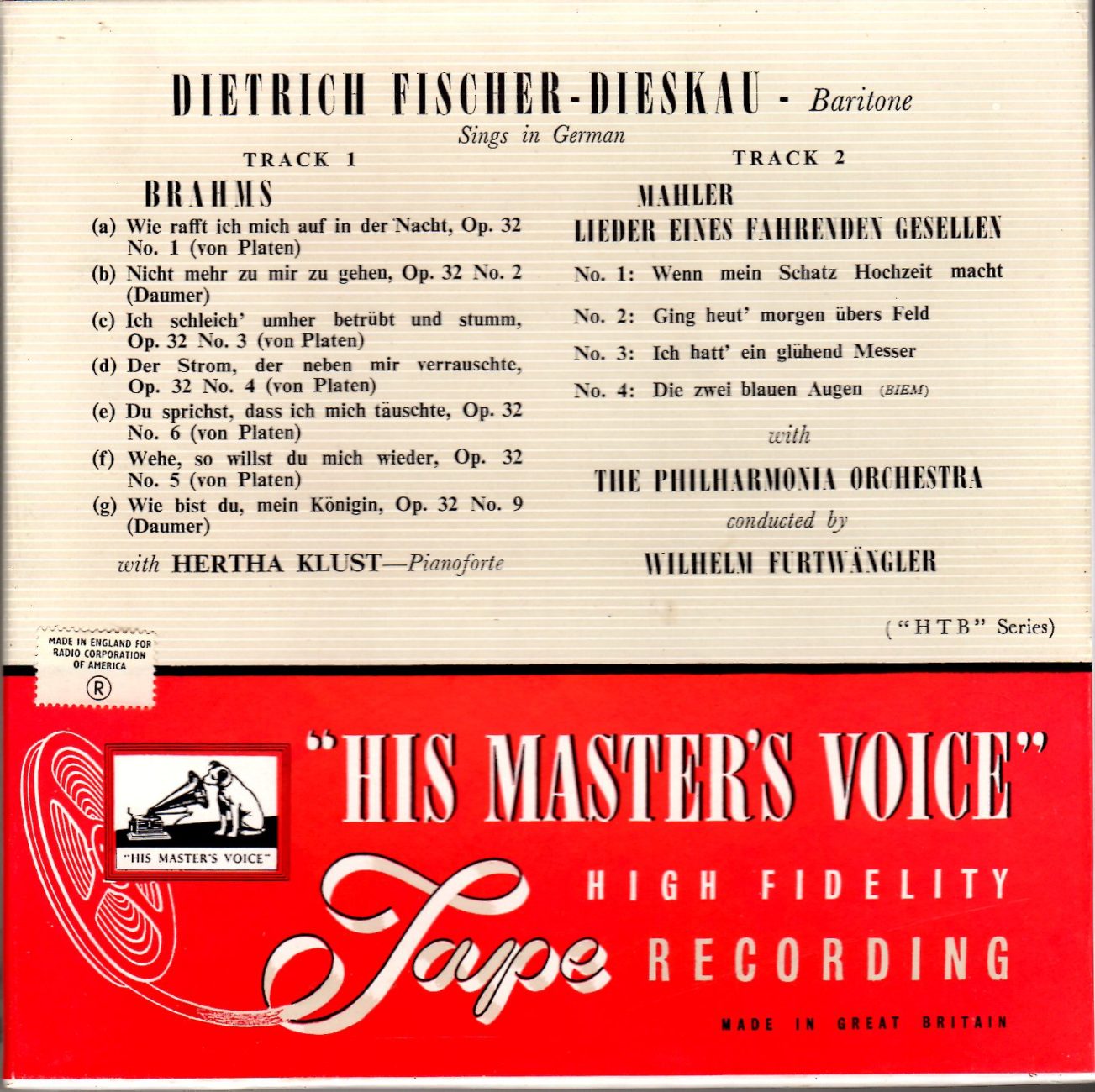
En 1956, HMV a publié ces enregistrements en microsillon (ALP 1270), mais aussi sous forme de bande magnétique HTB 409. Le couplage de ces deux œuvres est inhabituel, et ce d’autant plus que Fischer-Dieskau a enregistré en juin 1955 les Kindertotenlieder de Mahler avec le BPO sous la direction de Rudolf Kempe. Essayons d’en décrypter les raisons:
Les Lieder eines fahrenden Gesellen ont été enregistrés par Fischer-Dieskau et Furtwängler les 24 et 25 juin 1952 en profitant du temps d’enregistrement disponible après les séances consacrées à l’intégrale de Tristan und Isolde de Wagner.
Le 29 novembre 1953, Furtwängler écrit à Walter Legge en évoquant l’enregistrement du Monologue d’Amfortas en projet avec Fischer-Dieskau et le Philharmonia lors de sa venue à Londres en mars 1954: « J’imagine que les Lieder eines fahrenden Gesellen enregistrés avec Fischer-Dieskau n’ont toujours pas été publiés. Comme je fais dans les prochains jours les Kindertotenlieder avec Fischer-Dieskau à Berlin, ce serait semble-t-il une bonne idée de les enregistrer à la place du Monologue d’Amfortas si on dispose d’assez de temps ». Le 3 décembre, Legge confirme ce changement. De plus, entre les deux concerts de Furtwängler prévus avec le Philharmonia au Royal Festival Hall les 5 et 12 mars 1954, un étonnant Récital de Lieder de Schumann avait été programmé le 7 mars dans cette même salle avec Fischer-Dieskau et Schwarzkopf, Furtwängler étant au piano. Legge propose le programme suivant: Dichterliebe, Frauenliebe und Leben et 15 Duos.
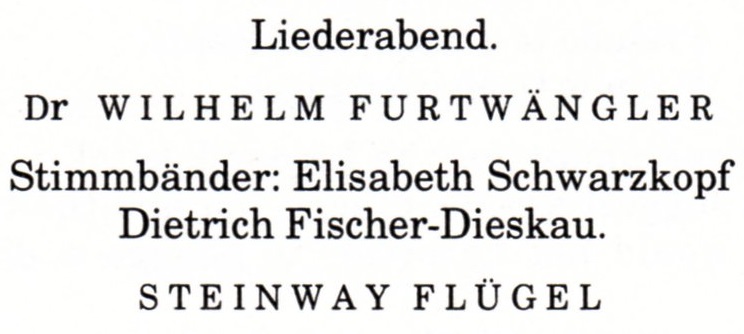
Le 12 janvier 1954, Furtwängler écrit à Legge depuis le sanatorium d’Ebersteinburg (Baden-Baden) où il doit séjourner pour se remettre des effets de ses traitements aux antibiotiques américains qu’il avait pris le mois précédent. Il a du annuler une tournée avec le BPO et une autre (au Portugal) avec le WPO, ainsi qu’une série d’autres concerts. Il annonce en outre qu’il ne pourra assurer à Londres que le concert du 12 mars. Il demande donc d’annuler le concert du 5 mars et le Récital du 7 mars. Le 18 janvier, Legge lui répond en exprimant ses regrets. Le 2 février, Furtwängler lui confirme qu’il ne dirigera que le concert du 12 mars et en confirme le programme. Le 7 février, Furtwängler écrit à Legge pour lui faire savoir que ses médecins l’autorisent finalement à reprendre ses activités le 1er mars et qu’il a programmé une série d’enregistrements avec le WPO (N.B. en fait du 28 février au 8 mars). Il n’est plus question d’enregistrer les Kindertotenlieder. Il n’en sera également pas fait état dans les échanges ultérieurs entre le chef et Legge.
Quant à Fischer-Dieskau, il recherchera activement, mais en vain, un enregistrement des Kindertotenlieder provenant des concerts berlinois de décembre 1953.
Dans ses mémoires, il laisse entendre qu’à l’époque il n’est pas satisfait de l’enregistrement qu’il en a fait avec Rudolf Kempe et le BPO en raison du manque d’entente entre l’orchestre et le chef. Ce sont probablement les raisons du choix du couplage Brahms/Mahler, grâce auquel la subtilité du piano d’Hertha Klust (1907-1970), que d’ailleurs Furtwängler appréciait beaucoup, mais dont la carrière fut semble-t-il abrégée par des problèmes auditifs, répondait à celle de la direction de Furtwängler.

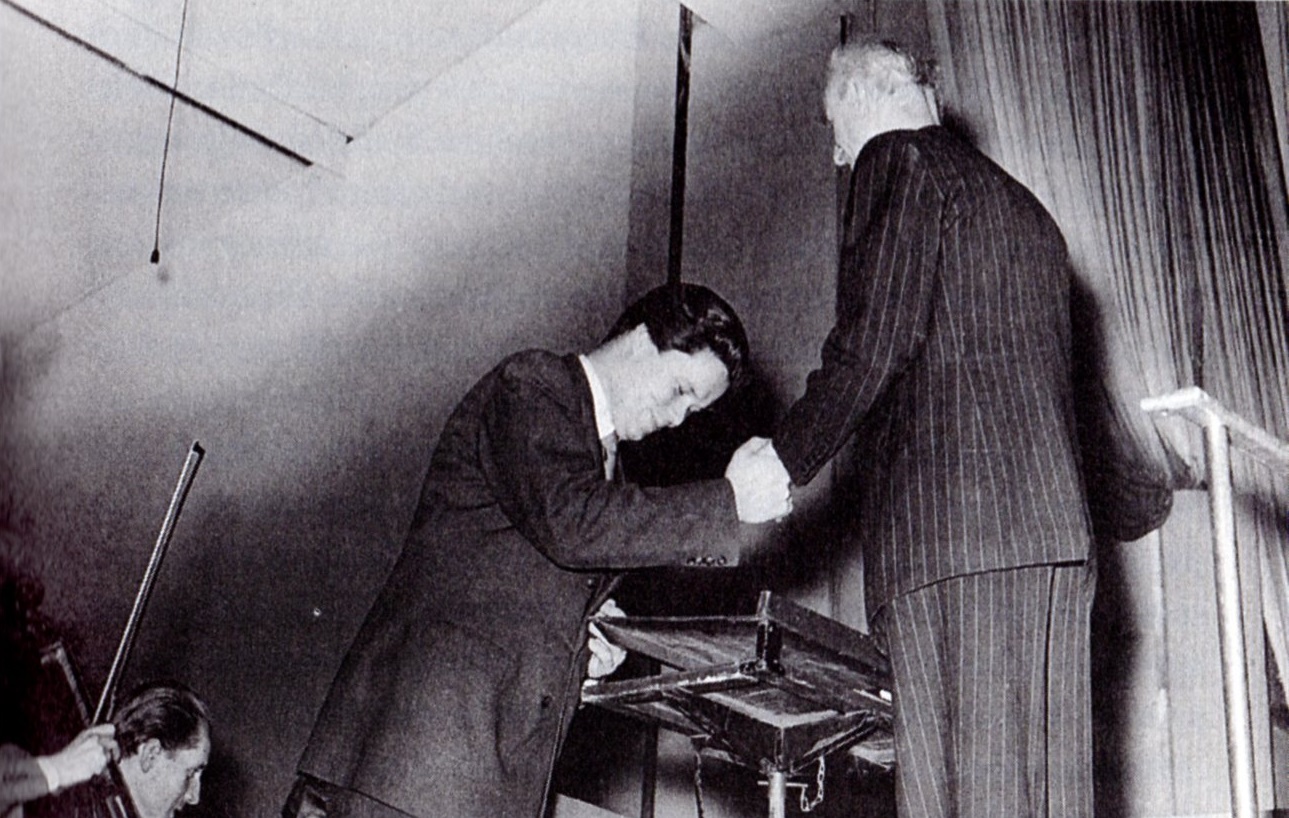
Dietrich Fischer-Dieskau & Wilhelm Furtwängler – Titania Palast Décembre 1953
______________
In 1956, HMV published these recordings as a LP (ALP 1270), but also on a reel-to-reel magnetic tape HTB 409. The coupling of these two works is unusual, al the more so, since Fischer-Dieskau recorded in June 1955 Mahler’s Kindertotenlieder with the BPO conducted by Rudolf Kempe. Let’s attempt an explanation:
The Lieder eines fahrenden Gesellen were recorded by Fischer-Dieskau and Furtwängler on June 24 and 25, 1952 during available recording time further to the sessions devoted to the complete recording of Wagner’s Tristan und Isolde.
On November 29, 1953, Furtwängler writes to Walter Legge and mentions the project recording of the Amfortasmonolog with Fischer-Dieskau and the Philharmonia during his stay in London in March 1954: « I gather that the Lieder eines fahrenden Gesellen with Fischer-Dieskau, which we recorded, have still not been released. As I am doing the Kindertotenlieder with Fischer-Dieskau in Berlin in the next few days, it would seem to be a good idea to record this as well – instead of the Amfortasmonolog – if there is time ». On December 3, Legge confirms the change. Moreover, between both Furtwängler’s concerts arranged with the Philharmonia at the Royal Festival Hall on March 5 and 12, 1954, an astonishing Recital of Lieder by Schumann had been scheduled on March 7 in the same venue with Fischer-Dieskau and Schwarzkopf, Furtwängler being the pianist. Legge suggests the following program: Dichterliebe, Frauenliebe und Leben and 15 Duets.

On January 12, 1954, Furtwängler writes to Legge from the Ebersteinburg sanatorium (Baden-Baden) were he has to stay to undergo a course of treatment which became necessary as a consequence of American antibiotics which were given to him the previous month. He had to cancel a tour with the BPO and another one (in Portugal) with the WPO, as well as a series of other concerts. He also mentions he will be able to conduct only the second London concert on March 12. As a consequence, he requests the cancellation of the March 5 concert as well as of the Recital of March 7. On January 18, Legge answers and expresses his regrets. On February 2, Furtwängler confirms he will conduct only the March 12 concert and also confirms the program. On February 7, Furtwängler writes to Legge to inform him that his doctors can discharge him as early as March 1st and that he has arranged with the WPO to do some recordings during that period (N.B. in fact between February 28 and March 8). It is no longer contemplated to record the Kindertotenlieder. Nor will this recording be further discussed in the next letters between the conductor and Legge.
As to Fischer-Dieskau, his active searches to find a recording of the Kindertotenlieder from the December 1953 Berlin concerts remained fruitless.
In his memoirs, the singer suggests that he was then not satisfied with the recording of this work he made with Rudolf Kempe and the BPO, because of the lack of understanding between the orchestra and the conductor. These are probably the reasons for the choice of the Brahms/Mahler coupling, thanks to which the subtility of the piano of Hertha Klust (1907-1970), whom by the way Furtwängler liked very much, but whose career was most probably shortened by hearing problems, mirrored that of Furtwängler’s conducting.
Les liens de téléchargement sont dans le premier commentaire. The download links are in the first comment.
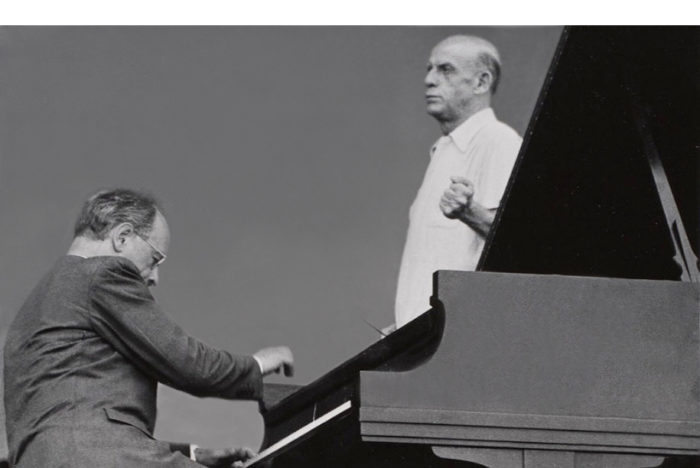
Rudolf Serkin – Dimitri Mitropoulos NYPO
Carnegie Hall – 31 octobre 1948 – Violoncelle solo: Leonard Rose
Source: Bande/Tape 38 cm/s / 15 ips
Entre le Concert du 20 février 1936 (Beethoven Concerto n°4 Op.58 & Mozart Concerto n°27 K.595 avec Arturo Toscanini) et le « Rudolf Serkin Golden Jubilee Program » du 20 février 1986 (Beethoven Concerto n°4 Op.58 avec Zubin Mehta), Rudolf Serkin a joué plus de 110 fois avec le NYPO, dont 27 Concerts sous la direction de Dimitri Mitropoulos, mais aucun disque avec ce dernier n’en est résulté. Ce rare enregistrement du Concerto n°2 de Brahms représente leur première collaboration avec le NYPO. L’interprétation est d’une rare intensité et il est donc tentant de la comparer avec la célèbre version Edwin Fischer/Wilhelm Furtwängler dont le style est bien sûr très différent.
(Enregistré sur disques 33 tours 40 cm à gravure directe, reportés ensuite sur bande magnétique).
_________________
New York Philharmonic – Concerts avec/with Rudolf Serkin & Dimitri Mitropoulos
(Carnegie Hall sauf indication contraire / Carnegie Hall unless otherwise indicated)
– Oct. 28, 29 & 31, 1948 Brahms Concerto n°2 Op.83
– Jan. 5, 6, 1950 Reger Concerto Op.114
– Jan. 7, 8,1950 Beethoven Concerto n°4 Op.58
– Nov. 13, 1950 Mozart Rondo K.382; Schumann Introduction & Allegro Op.134 (US Premiere), Mendelssohn Concerto n°1 Op.25; Strauss Burleske.
– Sept. 1, 1951(Edinburgh Usher Hall) Schumann Concerto Op.54
– Nov. 22, 23 & 25, 1951 Brahms Concerto n°1 Op.15
– Jan. 28 & 29, 1954 Mozart Concerto n°17 K.453; Strauss Burleske; Beethoven Concerto n°4 Op.58
– Febr. 17, 18 & 20, 1955 Brahms Concerto n°2 Op.83
– June 20, 1955 (Lewisohn Stadium – Manhattan) Beethoven Concerto n°5 Op.73
– Oct 20, 21, 1955 Mozart Concerto n°25 K.503, n°16 K.451 & n°23 K.488
– Oct 23, 1955 Mozart Concerto n°16 K.451 & n°25 K.503
– Febr. 28, March 1, 1957 Beethoven Concerto n°4 Op.58
– Febr. 6, 7 & 9, 1958 Schumann Introduction & Allegro Op.134; Strauss Burleske
– Febr. 8, 1958 Reger Concerto Op.114
(Une date soulignée indique un concert radiodiffusé/ an underlined date indicates a broadcast concert)
_________________
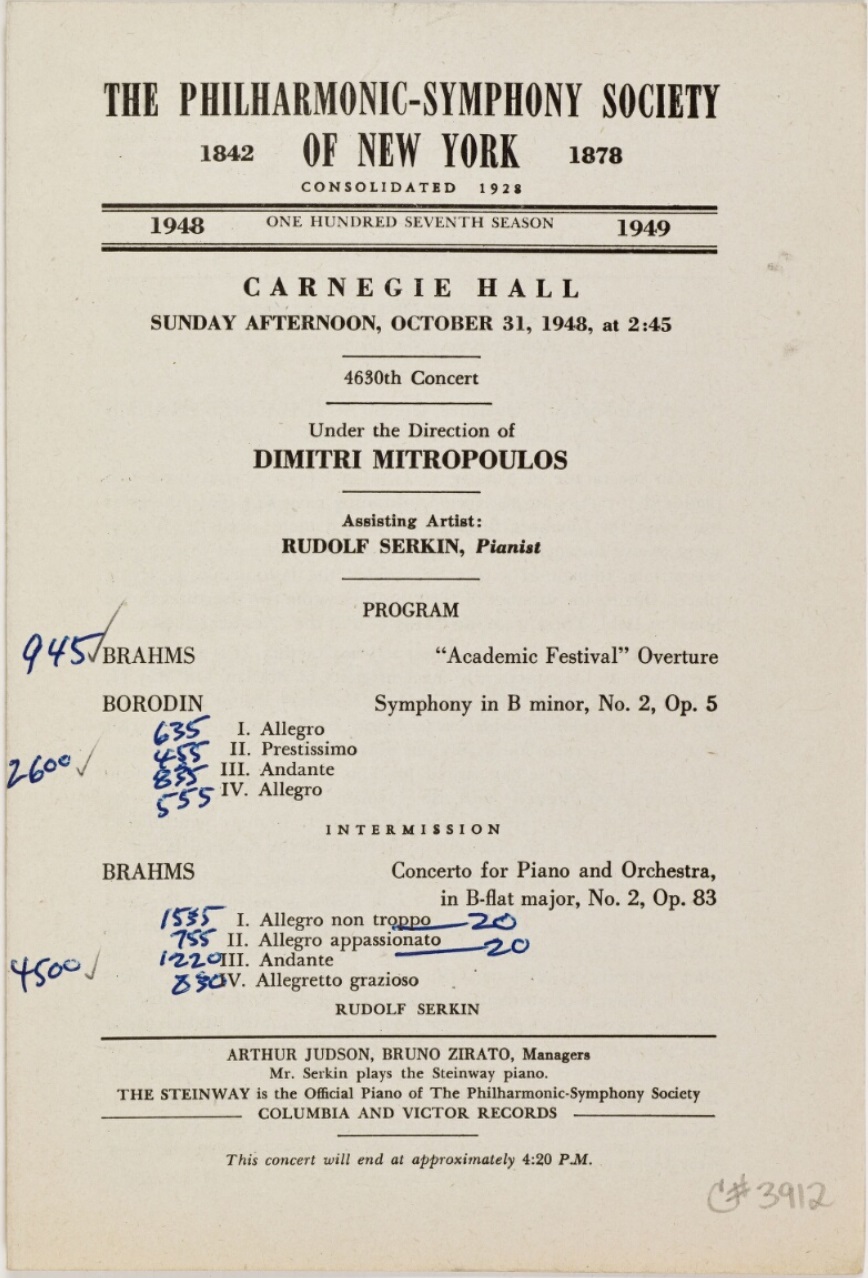

_________________
Between the Concert of February 20, 1936 (Beethoven Concerto n°4 Op.58 & Mozart Concerto n°27 K.595 with Arturo Toscanini) and the « Rudolf Serkin Golden Jubilee Program » of February 20, 1986 (Beethoven Concerto n°4 Op.58 with Zubin Mehta), Rudolf Serkin performed more than 110 times with the NYPO, including 27 Concerts (listed above) under the direction of Dimitri Mitropoulos, but no commercial recording with the latter ever materialized. This rare recording of Brahms’ Second Concerto n°2 (solo cellist: Leonard Rose) represents their first collaboration with the NYPO. The performance has a rare intensity, and for that matter, it is tempting to compare it with the well-known version with Edwin Fischer and Wilhelm Furtwängler, who of course play in a very different style.
(Recorded on 33rpm 16″ Transcription Discs later dubbed on magnetic tape).
_________________
Les liens de téléchargement sont dans le premier commentaire. The download links are in the first comment.
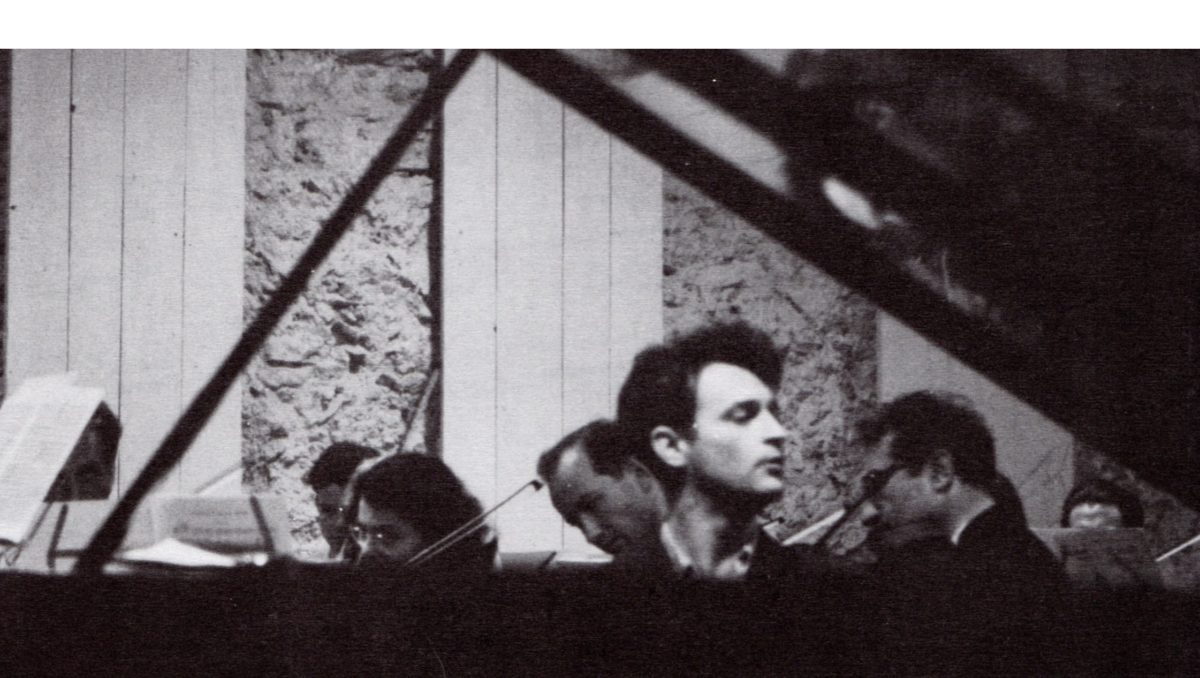
William Kapell – Dimitri Mitropoulos NYPO
Carnegie Hall – April 12 1953
Source: Bande/Tape 19 cm/s / 7.5 ips
La source utilisée jusqu’à présent pour les rééditions de cet enregistrement présente un spectre de fréquences tronqué dans l’aigu, ce qui se traduit par un son quelque peu étouffé qui empêche d’apprécier la splendeur sonore du piano de William Kapell (1922-1953), et aussi de l’orchestre.
La bande recopiée ici est en tout point supérieure et permet de restituer enfin cette grande interprétation que Kapell a donnée pour sa dernière apparition à New York avec un orchestre.

Pour sa dernière saison complète, Kapell a joué à travers les Etats-Unis un ambitieux programme de concertos, avec notamment trois apparitions à New-York, à savoir les 27 et 28 novembre 1952 (avec Dimitri Mitropoulos) pour le Concerto N°17 K. 453 de Mozart qu’il rejouera à Prades l’été suivant sous la direction de Pablo Casals, le 30 décembre 1952 pour le 3ème Concerto de Prokofiev avec le Philadelphia Orchestra (direction Alexander Hilsberg) et enfin les 11 et 12 avril 1953, pour le Concerto n°1 de Brahms, en lieu et place du 3ème Concerto de Prokofiev prévu initialement:
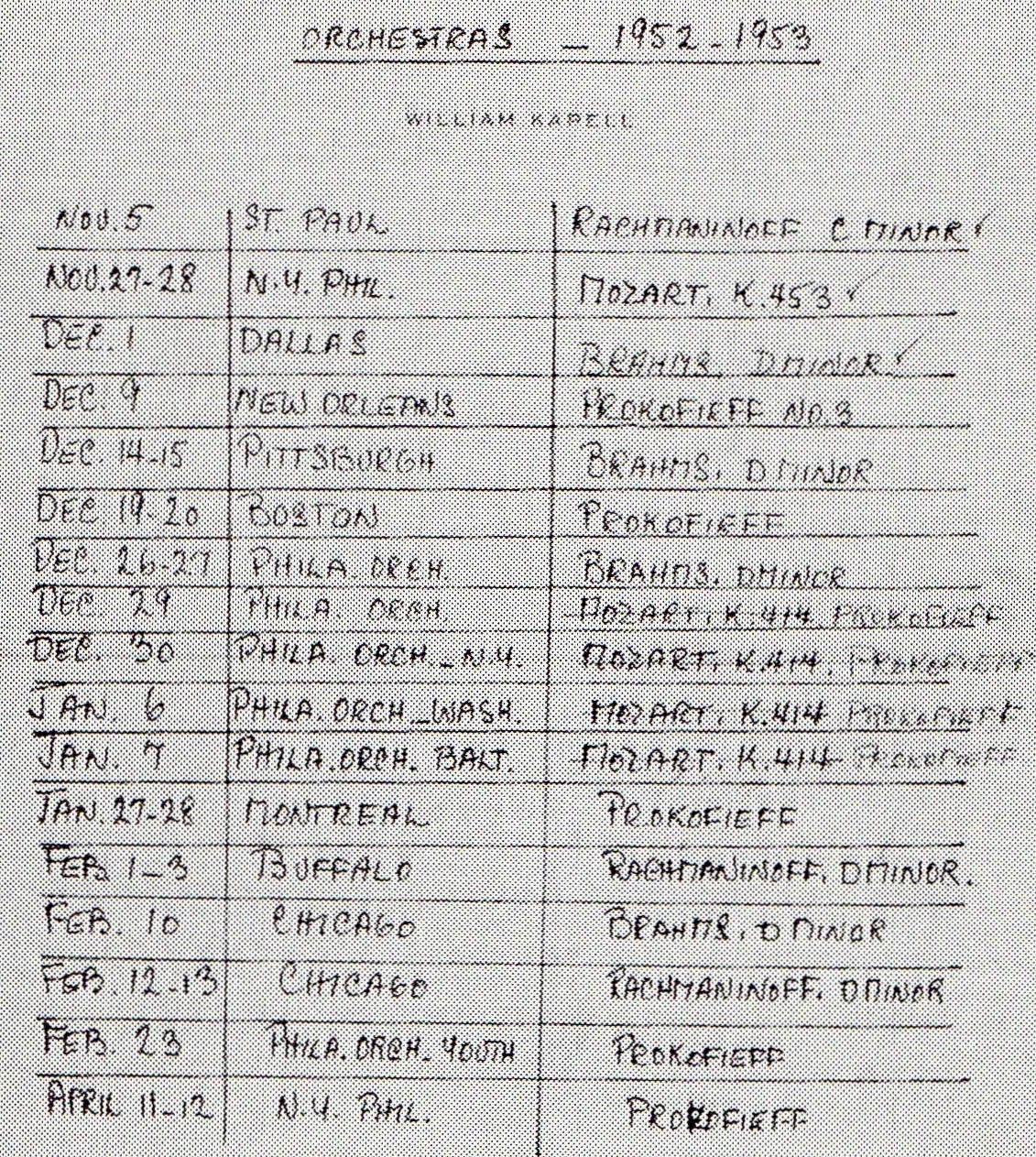
Après le concert du 1er décembre à Dallas avec le Concerto Op.15 de Brahms, le chef Walter Hendl lui a adressé une lettre dans laquelle il écrivait: « I have come to the conclusion that you are the great American pianist » (« J’en suis arrivé à la conclusion que vous êtes le grand pianiste américain »).
Les archives ont conservé des copies annotées des programmes des deux concerts des 11 et 12 avril 1953, et il y a de grandes différences de minutage: le 12, pour le concert radiodiffusé, les premier et deuxième mouvements durent chacun environ une minute de plus.
Nul doute que le pianiste et le chef ont modifié leur approche, probablement lors de la répétition pour le concert du dimanche, qui n’a pas le même programme que le précédent.
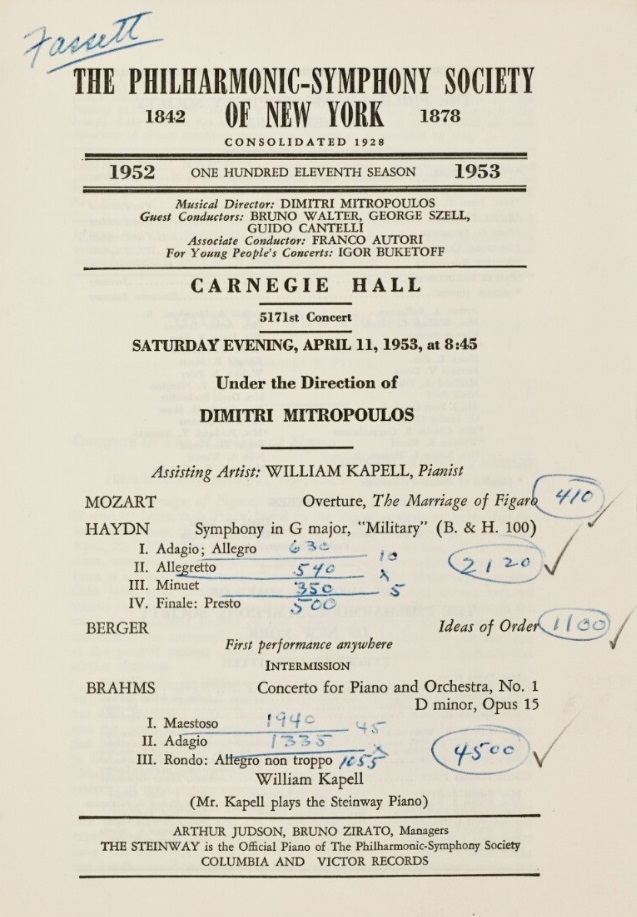

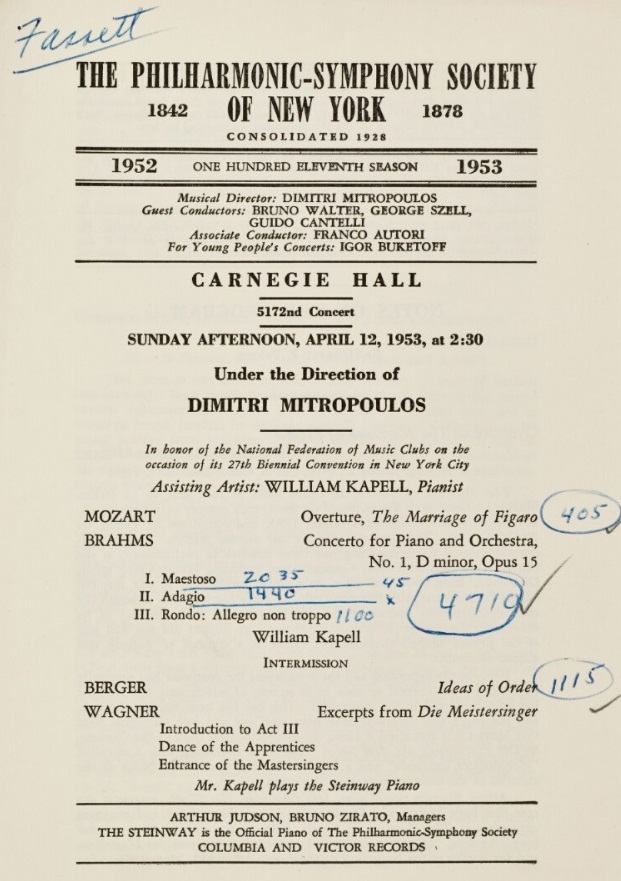
Bien sûr, un minutage différent n’est qu’une vague indication, mais fort heureusement, Harriett Johnson, critique du New York Post a assisté aux deux concerts et nous donne ainsi de précieux commentaires. Ainsi, lors du deuxième concert, l’interprétation était selon elle beaucoup plus détendue et de ce fait beaucoup plus éloquente. Dans ce contexte, elle pointe une tendance du pianiste à se laisser entraîner par sa propre intensité, d’où un excès de tension, une virtuosité trop marquée et une sonorité métallique. L’interprétation de l’Adagio est notée pour son intensité pénétrante, sa vitalité rayonnante et la beauté du phrasé. L’article du Musical Courier (May 1, 1953) va dans le même sens en soulignant, en ce qui concerne le premier concert, la chaleur rhapsodique de l’interprétation, mais aussi le tempo très rapide du premier mouvement, la grande virtuosité et un côté parfois plutôt percussif du jeu du pianiste.
Quoiqu’il en soit, avec ce concert radiodiffusé, nous disposons de la meilleure des deux prestations des interprètes, soliste et chef.
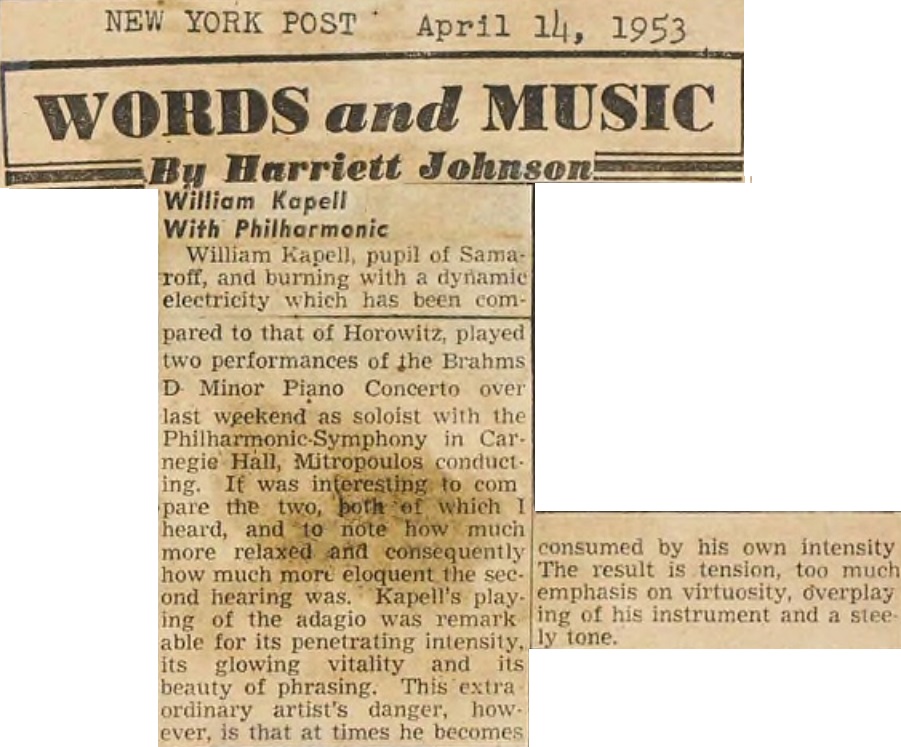
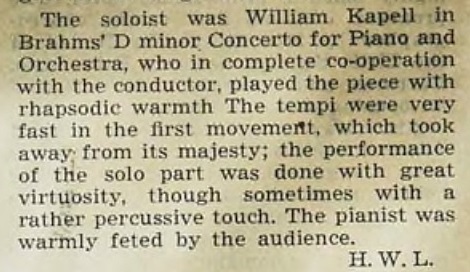
Musical Courier May 1, 1953 (critique du concert du 11 avril)
________________
The source that was used for the previous re-issues of this recording is truncated in the high frequencies, so that the sound is somewhat muffled which does not allow to appreciate the splendid piano sound of William Kapell (1922-1953), and also the orchestra.
The tape dubbed here is vastly superior and fully allows to hear the great performance given by Kapell for his last orchestral concert in New-York.
Fot his last complete season, Kapell performed through the United States an ambitious program of concertos, with no less than three programs in New York, namely on November 27 and 28, 1952 (with Dimitri Mitropoulos) for Mozart’s Concerto N°17 K. 453 he would later perform at the Prades Festival the following summer under the direction of Pablo Casals, on December 30, 1952 for Prokofiev’s Third Concerto with the Philadelphia Orchestra (conducted by Alexander Hilsberg) and to end with, on April 11 and 12, 1953 for Brahms’ First Concerto, instead of the previously scheduled Prokofiev’s Third Concerto.
After the December 1st, concert in Dallas with this Brahms Concerto, the conductor Walter Hendl sent him a letter in which he wrote « I have come to the conclusion that you are the great American pianist ».
The archives have kept annotated copies of the programs of both concerts of April 11 and 12, 1953, and there are major differences in timings: on the 12th, for the broadcast concert, each of the first and the second movements lasts about one full minute longer.
It is clear that both pianist and conductor have reconsidered their approach, probably during the rehearsal for the Sunday concert, whose program is different.
A different timing is of course merely a vague indication, but quite happily, Harriett Johnson, critic for the New York Post attended both concerts and provides us with precious comments. Indeed, at the second concert, the performance was for her much more relaxed and consequently much more eloquent. In this context, she points out the pianist’s tendency toward becoming consumed by his own intensity, the result being tension, too much emphasis on virtuosity, overplaying of the instrument and a steely tone. According to her, the performance of the Adagio was remarkable for its penetrating intensity, its glowing vitality and its beauty of phrasing. The article in the Musical Courier (May 1, 1953) goes in the same direction. It underlines, as far as the first concert is concerned, the rhapsodic warmth of the performance, but also the very fast tempo of the first movement, and the pianist’s great virtuosity and his sometimes rather percussive touch.
Be it as it may, with this broadcast concert, we have the best of the two performances, both for the soloist and the conductor.
Les liens de téléchargement sont dans le premier commentaire. The download links are in the first comment.
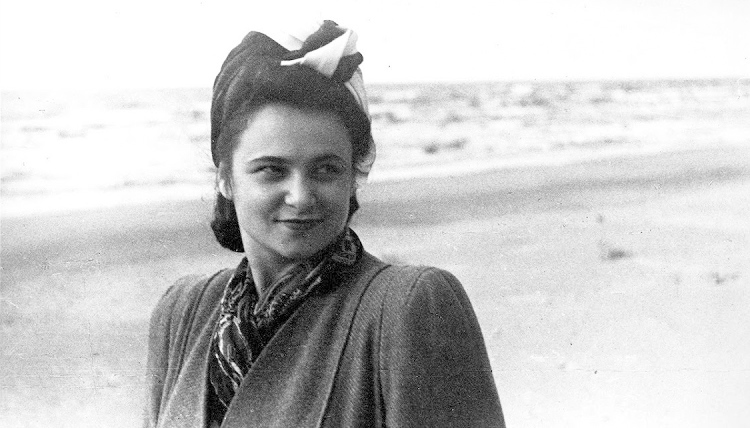
Rosa Tamarkina, piano; Isaac Zhuk & Boris Weltman, violons;
Moris Gurvich, alto; Isaac Buravsky, violoncelle
Enregistré en 1948
English translation: click here
Rosa Tamarkina (Kiev 1920 – Moscou 1950) a eu, à l’instar de Dinu Lipatti, une carrière aussi courte que brillante, qui a été interrompue par une cruelle maladie.
Entre 1932 et 1935, elle est l’élève de Nadezda Goldenberg au Conservatoire de Kiev, avant d’étudier au Conservatoire de Moscou. En 1935, elle publie ses premiers enregistrements. En 1937, avant même la fin de ses études, elle obtient le 2ème Prix du Troisième Concours Chopin de Varsovie. Sa technique, mais surtout sa forte personnalité et sa maturité musicale précoce impressionnent le jury composé notamment d’Henryk Neuhaus, Emil von Sauer et Wilhelm Backhaus. Elle poursuit cependant ses études au Conservatoire de Moscou jusqu’en 1945, avec Alexander Goldenweiser, puis Konstantin Ignumov. Elle commence à y enseigner en 1946.
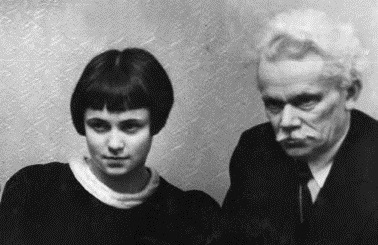
Rosa Tamarkina & Alexander Goldenweiser en 1937
Entre 1940 et 1944, elle est l’épouse d’Emil Gilels.
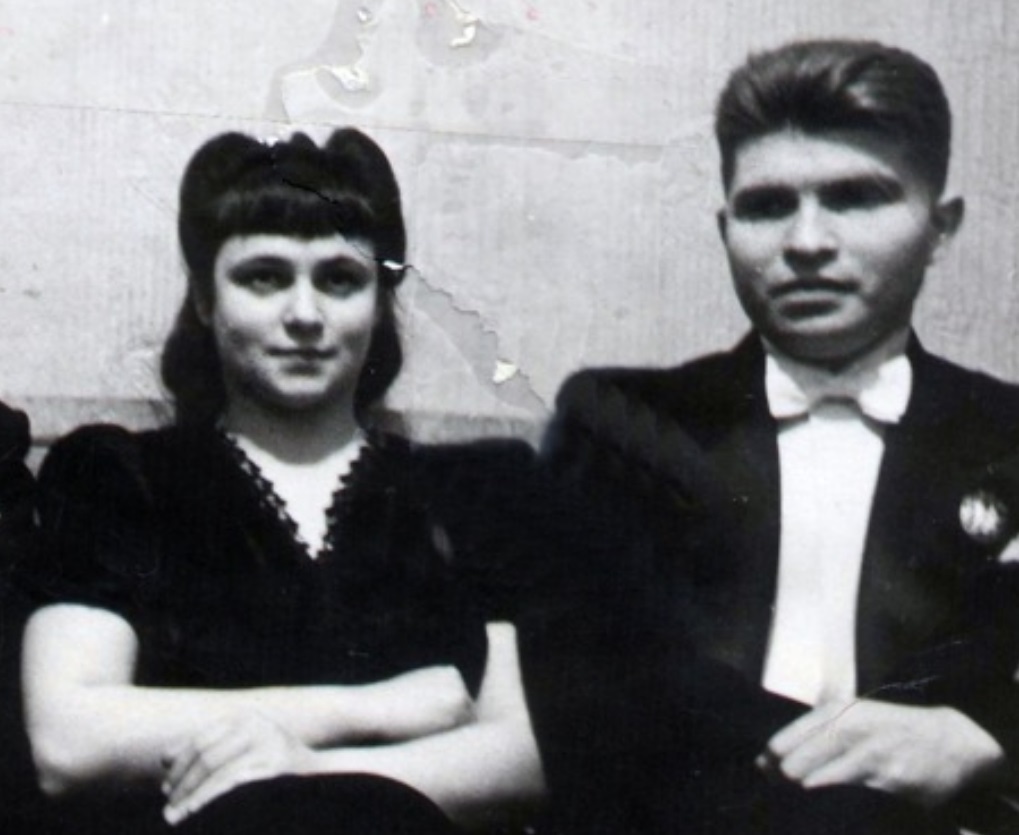
Sa maladie, diagnostiquée en 1946, la contraint à limiter le nombre de ses concerts. Sa dernière apparition publique a lieu en octobre 1949 (Chopin Concerto en fa mineur).
Sa discographie est très limitée, mais suffisante pour donner une idée de son immense potentiel: une poignée d’œuvres pour piano seul, la Sonate de Franck avec la violoniste Marina Kosolupova (1918-1978), les Quintettes de Brahms et de Taneïev avec le Quatuor du Théâtre Bolshoï (ils ont également joué le Quintette de Schumann, mais il ne semble pas qu’un enregistrement existe), et enfin le Concerto n°2 de Rachmaninov sous la direction de Nikolaï Anosov.
_________________
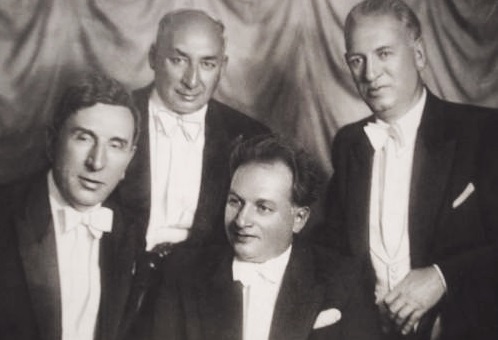
Quatuor du Théâtre Bolshoï: Isaac Zhuk, Boris Weltman, Moris Gurvich & Isaac Buravsky
Le Quatuor du Théâtre Bolshoï, c’est à dire du « Grand Théâtre de Moscou », a été fondé en 1931 par Isaac Zhuk (1902-1973), Boris Weltman (1899-1967), Moris Gurvich (1909- ?) et Sviatoslav Knushevitsky (1908-1963), remplacé en 1933 par Vladimir Matkovsky, puis en 1935 par Isaac Buravsky (1898-1969). A part ces changements concernant le pupitre de violoncelle, la seule modification intervenue jusqu’à la dissolution du Quatuor en 1968 a été le remplacement en 1957 de l’altiste par Galina Matrosova, élève de Vadim Borisovsky, l’altiste du Quatuor Beethoven.
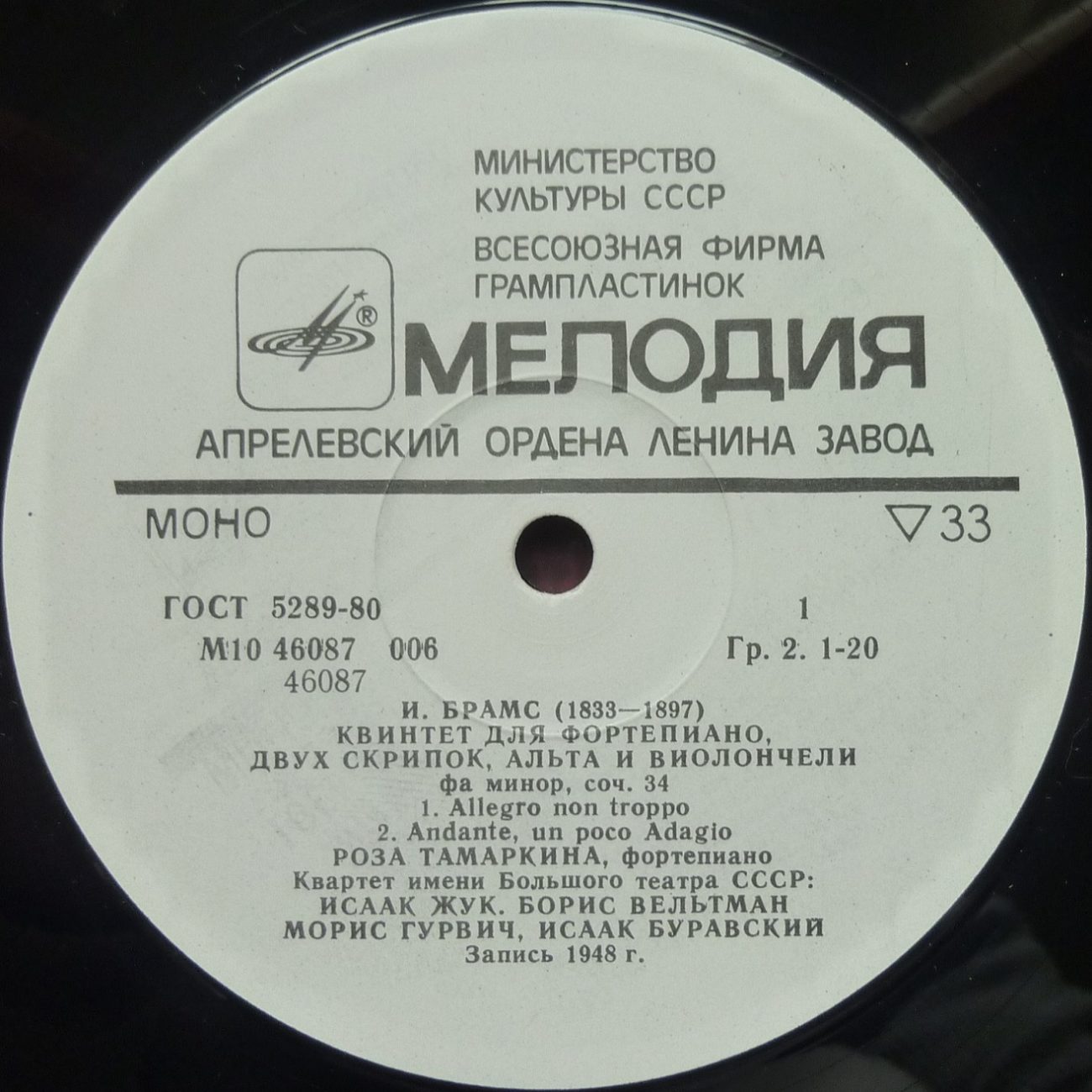
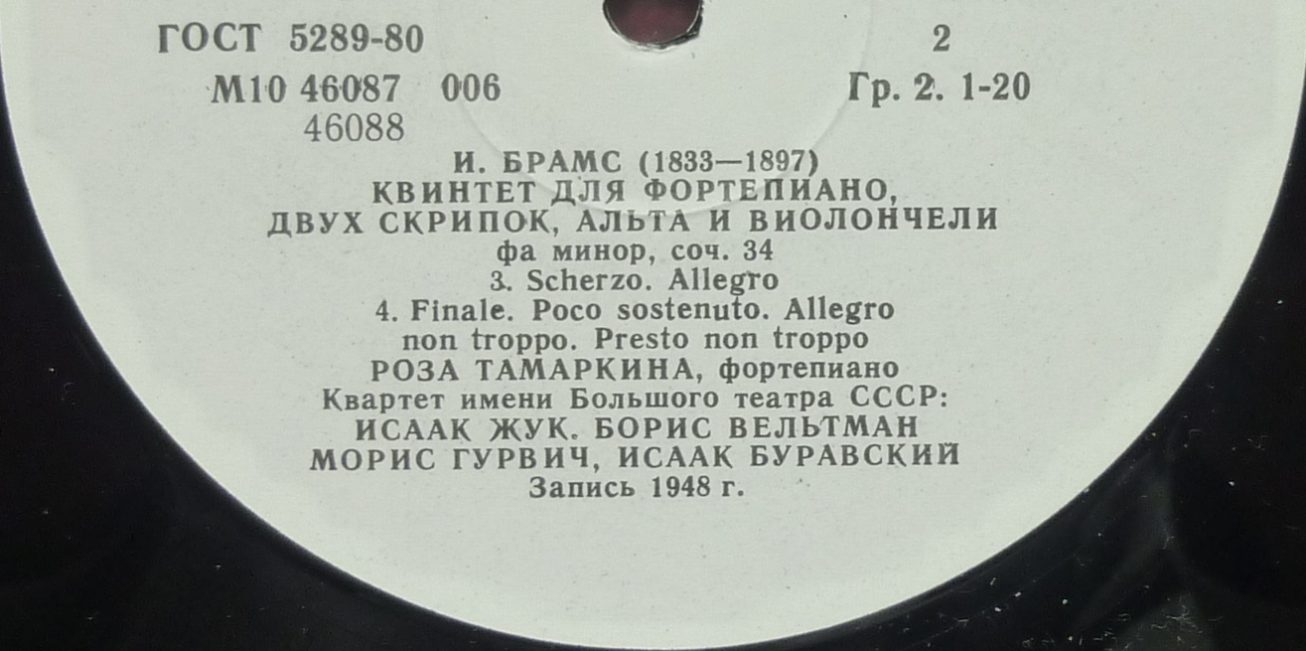

_________________
Les liens de téléchargement sont dans le premier commentaire. The download links are in the first comment.
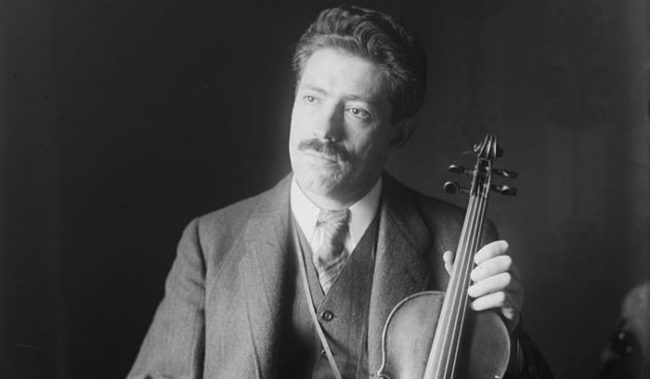
Staatskapelle Berlin dir: Leo Blech – Berlin Singakademie
__________
Beethoven Concerto Op. 61
14 au 16 décembre 1926
DB990-995 – Matrices CWR 631-641 (Beethoven)
14 décembre: CWR 631 1A, CWR 632 2, CWR 633 1A; 15 décembre: CWR 636 3A, CWR 637 2A, CWR 638 2, CWR 639 3A;
16 décembre: CWR 634 4A, CWR 635 2, CWR 640 2, CWR 641 2A
Bonus: Bach Sonate n°1 BWV 1001 (Adagio) Fritz Kreisler: 16 décembre CWR 642
__________
Brahms Concerto Op. 77
21, 23 & 25 Novembre 1927
Beethoven: 33t. EMI-Toshiba (1971); Brahms: 33t. Melodiya
En décembre 1926, Leo Blech et Fritz Kreisler ont enregistré le Concerto de Mendelssohn Op.64 (les 9 & 10), puis du 14 au 16, le Concerto Op.61 de Beethoven.
Entre temps, le 12 et le 13, Kreisler a joué le Concerto Op.61 de Beethoven en public avec les Berliner Philharmoniker, cette fois sous la direction de Bruno Walter.
On ne saurait en déduire que le partenariat entre Blech et Kreisler qui a donné les enregistrements de ces trois grands Concertos était de pure circonstance. Si en effet le Concerto Op.77 de Brahms a été enregistré l’année suivante, il avaient déjà donné à Berlin une exécution de cette œuvre (avec le Concerto n°1 de Bruch) lors d’un concert des Berliner Philharmoniker en date du 9 décembre 1924.
En l’absence d’une liste des concerts de Leo Blech, notamment avec la Staatskapelle de Berlin (l’Orchestre du Staatsoper), ou de Fritz Kreisler, on ne peut dire si une collaboration régulière a existé entre eux et depuis quand. Leurs disques montrent en tout cas une entente d’une rare qualité1 .
En 1950, à l’occasion de son 75ème anniversaire, Kreisler a déclaré lors d’une cérémonie en son honneur:
« La musique est un art relativement indéfinissable. Juste un exemple: Comment un artiste peut-il arriver à une interprétation idéale de, disons, un Concerto ou une Sonate de Beethoven? Il n’existe pas de formule pour cela; nous n’avons pas de normes; nous n’avons pas d’exemples à consulter ou à copier; du moins, nous n’avons pas d’exemples universellement reconnus. De ce fait, tout artiste, en fonction de son tempérament et avec son intuition, doit concevoir et créer ses propres idéaux et les suivre dans l’espoir qu’un jour il pourra les atteindre…. Un artiste se rend compte très souvent que ses propres idéaux ont changé ou qu’il s’est beaucoup éloigné de son but. Il m’est arrivé une fois de penser que j’avais quasiment atteint mon propre idéal lors d’une exécution, mais il m’a fallu abandonner tout espoir de pouvoir y arriver de nouveau, car je me suis aperçu à quel point j’avais été aidé par des circonstances fortuites telle que mon état d’esprit, des conditions atmosphériques favorables et même les propriétés acoustiques de la salle où j’avais joué« .
La vie d’un artiste est un thème sur lequel on peut écrire beaucoup de variations ».
Bruno Walter, dont le livre de souvenirs est justement intitulé « Thème et Variations », a fait à cette occasion écho aux interrogations de Kreisler:
« Faire de la musique est pour Fritz Kreisler ce que voler est pour les oiseaux, ou nager pour les poissons. Et mon opinion est que c’est cette qualité élémentaire qui explique la magie qu’il exerce sur son auditoire, et qui transforme les événements éphémères de ses concerts en une expérience profonde et durable. Une heureuse étoile s’est mise à briller sur notre monde musical quand Fritz Kreisler y est apparu, quand il a pris son archet et son violon et a joué à pour l’oreille de plusieurs générations ses chants de beauté, de sérénité, de tristesse, de gaieté, de transfiguration et de bonheur ».
Kreisler avait sa propre conception de la technique (entrevue avec Samuel Applebaum):
« Pour la pratique instrumentale, on donne trop d’importance à la répétition physique, et pas assez au contrôle mental. La technique musculaire n’est pas seulement une question de développement musculaire, mais aussi d’implication mentale. J’ai souvent mémorisé un morceau de musique, parfois un Concerto important au cours d’un voyage en train. J’ai souvent joué des œuvres avec très peu de pratique préliminaire. Quand le Concerto d’Elgar m’a été dédié, je n’ai jamais mis un doigt sur la touche. Et puis, j’ai vu un passage que je pouvais améliorer et j’ai passé six heures dessus…. Je pratique seulement quand j’en ressens le besoin. C’est à la portée de beaucoup, s’ils développent leur cerveau depuis la prime enfance… Faire confiance à l’habitude musculaire, comme tellement de musiciens le font en matière de technique est en effet fatal. Un peu de fatigue, un peu de nervosité, un muscle perturbé et incapable de se contrôler et où êtes vous? Car la technique est vraiment un problème mental ».
1 Chacun de ces deux Concertos a bénéficié de trois jours d’enregistrement et le son est d’une qualité étonnante pour l’époque.
____________________

Fritz Kreisler Leo Blech BPO 9 décembre 1924 Bruch Concerto n°1 Brahms Concerto Op.77

Fritz Kreisler Bruno Walter BPO 12 & 13 décembre 1926 Beethoven Concerto Op.61
____________________
In December 1926, Leo Blech and Fritz Kreisler recorded Mendelssohn’s Concerto Op.64 (on 9th & 10th), then from the 14th to the 16th, Beethoven’s Concerto Op.61.
In between, on the 12th and the 13th, Kreisler performed the Beethoven’s Concerto Op.61 at concerts with the Berliner Philharmoniker, but conducted by Bruno Walter.
One should not draw therefrom the conclusion that the partnership between Blech and Kreisler that led to the recordings of these three great Concertos was purely a matter of circumstances. Whereas the Brahms Concerto Op.77 was recorded the following year, they gave a prior Berlin performance of this work (with Bruch’s Concerto n°1) during a concert of the Berliner Philharmoniker on December 9, 1924.
Without a list of the concerts given by Leo Blech, especially with the Berliner Staatskapelle (the Staatsoper Orchestra), or by Fritz Kreisler, it is not possible to tell whether a partnership existed between them on a regular basis and since when. However, their recordings testify to a rare understanding between them1.
In 1950, for his 75th birthday, Kreisler declared during a ceremony in his honour:
« Music is a rather indefinable art. For instance, to give you but an example: How can an artist achieve an ideal performance of, let us say, a Beethoven Concerto or a Sonata? There are no formulas for it; we have no norms; we have no examples which we could consult and copy; at least we have no universally acknowledged examples of it. Therefore, any artist, according to his temperament and through his intuition, has to conceive and create his own ideals and follow them in the hope that some day he may be able to attain it…. An artist very often realizes that his own ideals have changed or that he has receded further from his goal. I once, myself, thought I had come very near my own ideal in a certain performance,but I had to abandon all hopes of being able to repeat it, because I realized how much I had been aided by fortuitous circumstances, such as my disposition, favourable atmospheric conditions and even the acoustical properties of the hall in which I played.
The life of an artist is a theme on which many variations can be written ».
Bruno Walter, whose souvenir book is by the way titled « Theme and Variations », echoed Kreisler’s questions in a short address:
« To make music is for Fritz Kreisler what flying is for the birds, what swimming is for the fish. And I am of the opinion it is this elementary quality which explains the spell that he casts over his audiences, that changes the passing events of his concerts into a profound, lasting experience. So it was certainly a lucky star that shone upon our musical world when Fritz Kreisler appeared in it, when he took his bow and fiddle and played into the ears of generations his songs of beauty, of serenity, of sadness, of gaiety, of transfiguration and of happiness ».
Kreisler had his own way to technique (interview with Samuel Applebaum):
« Too much emphasis is being placed on physical repetition in practice, and not enough on mental control. Muscular technic is not a matter of muscular development alone, but of mental application. I have often memorized a piece of music, in some instances, an important Concerto while travelling on the train. I often played works with very little preliminary practice. When the Elgar Concerto was dedicated to me, I never put a finger on the fingerboard. Then I saw a passage I thought I could improve, and spent six hours on it…. I practice only when I feel the need. Many people are capable of doing this if they develop their minds from early youth… To rely on muscular habit, which so many do in technic, is indeed fatal. A little fatigue, a little nervousness, a muscle bewildered and unable to direct itself, and where are you? For technic is truly a matter of the brain ».
1 Each of these two Concertos was granted three recording days and the sound quality is astonishing for the period.
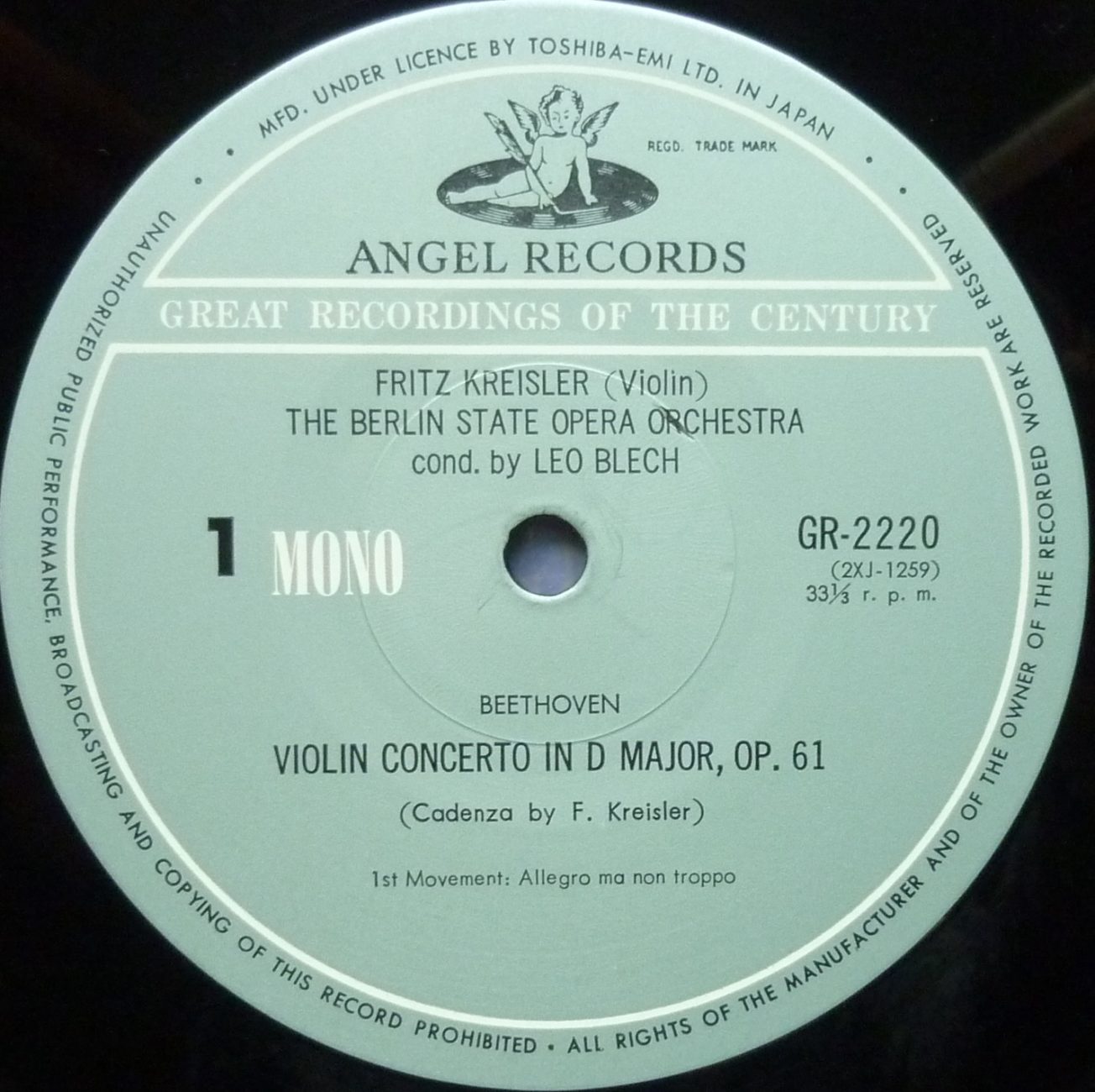
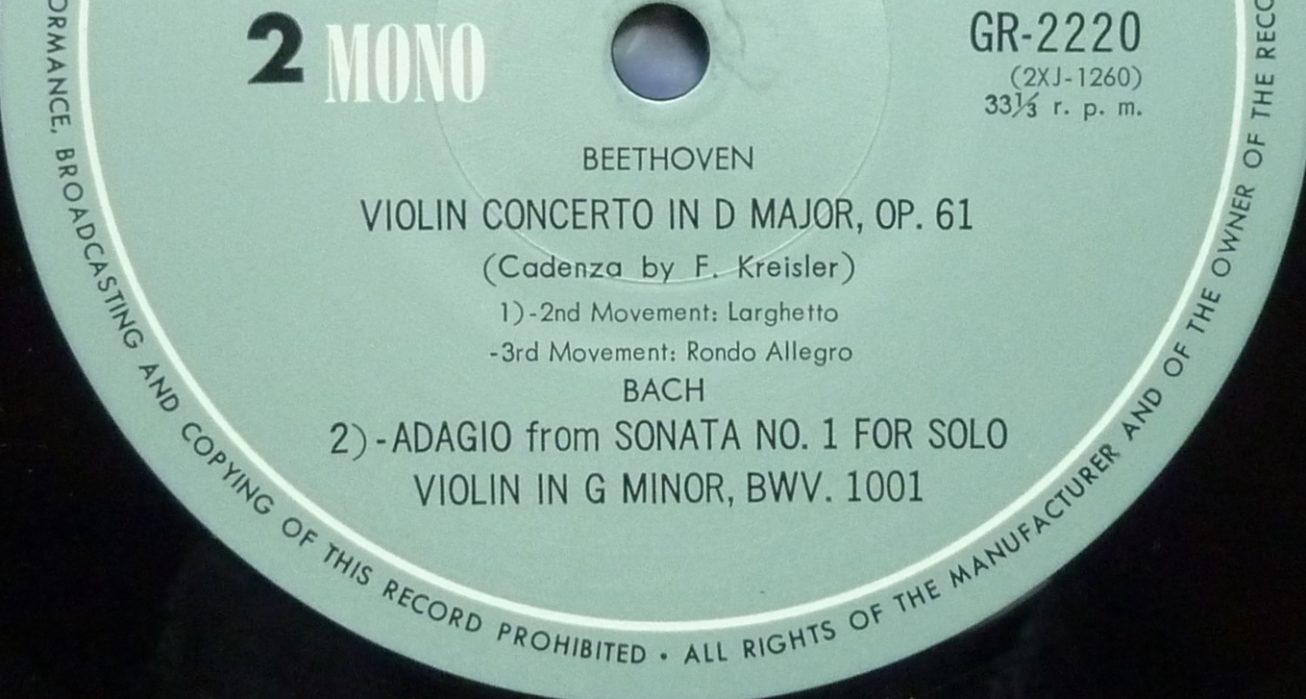
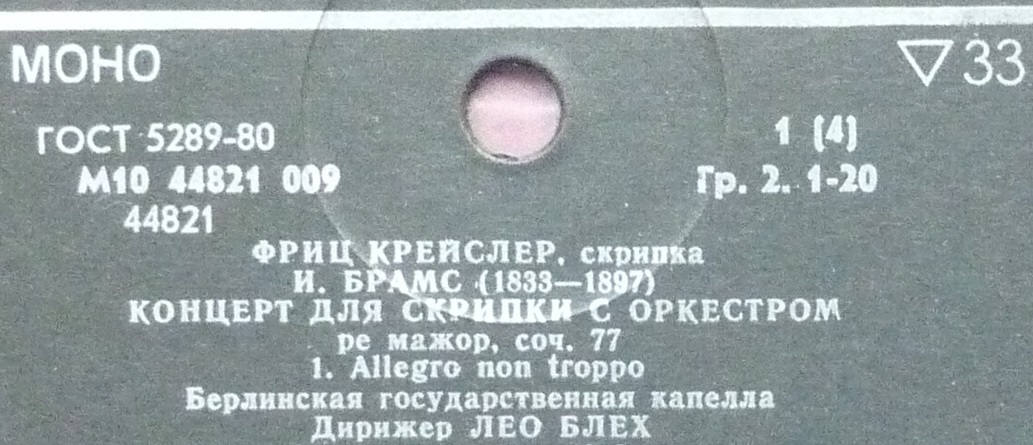

____________________
Les liens de téléchargement sont dans le premier commentaire. The download links are in the first comment.



